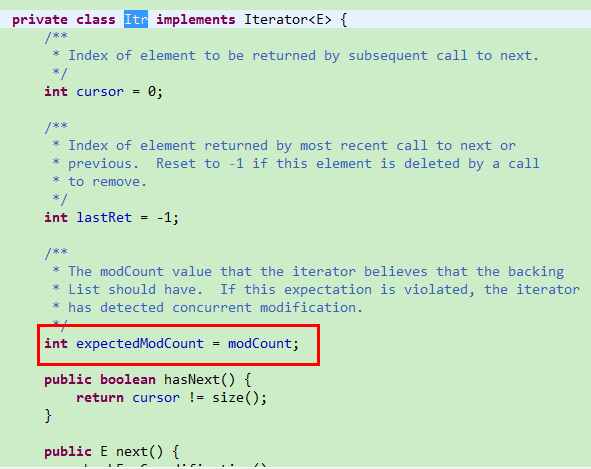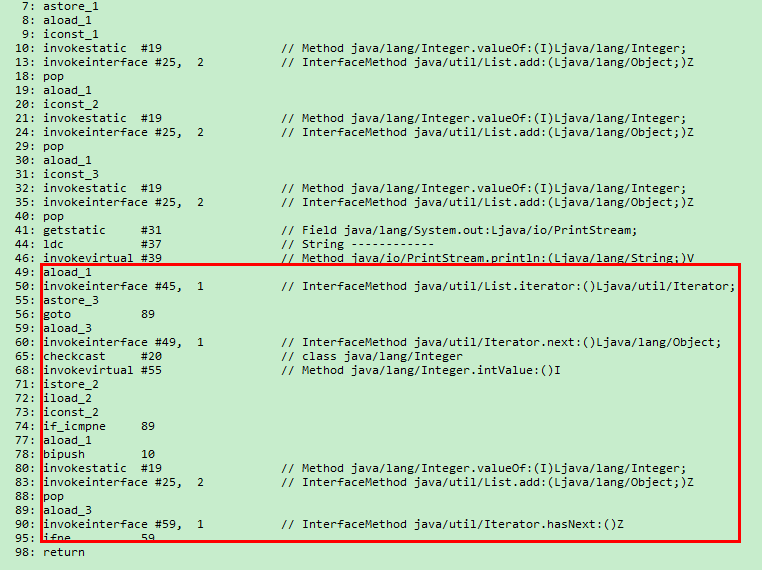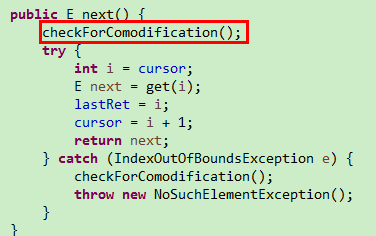Java併發修改錯誤ConcurrentModificationException分析
1. 介紹
併發修改ConcurrentModificationException錯誤是開發中一個常見錯誤,多發生在對一個Collection邊遍歷邊做影響size變化的操作中,下面以ArrayList為例分析ConcurrentModificationException錯誤。
2. 分析
ArrayList初始資料如下。
List<Integer> list = new ArrayList<Integer>();
list.add(1);
list.add(2);
list.add(3);場景1:不會有併發修改錯誤
int length = list.size();
for (int i = 0; i < length; i++) {
if (list.get(i).equals(2)) {
list.add(10);
}
}場景2:會有併發修改錯誤
for(int temp : list) {
if(temp == 2) {
list.add(10);
}
}場景3:會有併發修改錯誤
Iterator<Integer> iterator = list.iterator();
while(iterator.hasNext()) {
if(iterator.next().equals(2)) {
list.add(10);
}
}場景4:沒有併發修改問題
ListIterator<Integer> listIterator = list.listIterator();
while (listIterator.hasNext 其實ConcurrentModificationException異常的丟擲是由於checkForComodification(AbstractList類中)方法的呼叫引起的
private void checkForComodification() {
if (this.modCount != l.modCount)
throw new ConcurrentModificationException();
}而checkForComodification方法的呼叫發生在Iterator相關api方法中,
在呼叫list的iterator方法會建立一個Itr物件、

在建立會與AbstractList的modCount賦予相同的值, 而在Itr的next方法中會呼叫checkForComodification
在場景3中,list.add操作更改modCount的值,所以會有併發修改錯誤
而場景1中並沒有使用iterator相關api,add操作雖然修改了modCount但是不會檢查modCount所以沒有併發修改錯誤。
場景4中,ListItr類add方法
public void add(E e) {
checkForComodification();
try {
int i = cursor;
ArrayList.this.add(i, e);
cursor = i + 1;
lastRet = -1;
expectedModCount = modCount;
} catch (IndexOutOfBoundsException ex) {
throw new ConcurrentModificationException();
}
}其中9行:在呼叫了list.add操作之後,將ListItr中的expectedModCount與AbstractList中的modCount進行了同步,所以在下次呼叫next也就不會丟擲異常了,此時假如以後不呼叫next或者又重新建立了 ListItr也不會有異常丟擲。
最後場景2並沒有使用Iterator中的api為什麼也丟擲了異常了。其實編譯器會將for-each迴圈程式碼編譯為Iterator相關api的呼叫。
為了便於檢視編譯後的程式碼這裡新增一個“———-”列印。
List<Integer> list = new ArrayList<Integer>();
list.add(1);
list.add(2);
list.add(3);
System.out.println("------------");
for (int temp : list) {
if (temp == 2) {
list.add(10);
}
}編譯後的位元組碼為:

所以場景2和場景3是一樣的,也會丟擲異常了。

